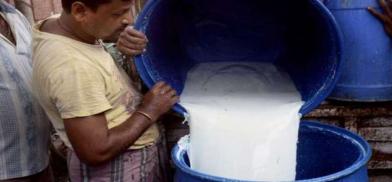How India utilized its surplus milk - and did not dump it
Even as litres of fresh milk produce is being dumped in the US and parts of Europe, the giant milk cooperative networks in India continues to feed the country as well as millions of dairy farmers during the lockdown

Even as litres of fresh milk produce is being dumped in the US and parts of Europe, the giant milk cooperative networks in India continues to feed the country as well as millions of dairy farmers during the lockdown. Milk cooperatives like Mother Dairy, Amul, Nandini, Parag and several others walked an extra mile to procure surplus milk from the farmers while hundreds of milk plants across the country produced skimmed milk powder to utilize supply of excess milk.
"In a country of 1.35 billion, we ensured uninterrupted supply of milk to every household...and we also protected the interest of millions of dairy farmers during the lockdown," Dilip Rath, Chairman of National Dairy Development Board (NDDB) told IANS.
The countrywide lockdown impacted the purchasing power of the people as much of the commercial institutes, markets and factories were shut. Consequently consumption and sale of dairy items had to bear a major dent.
But despite these odds, the cooperative model in India went out of the way to protect the milk producers. In the US, the crippled supply chains compelled the dairy farmers to dump their milk. Similar situation was seen in parts of Europe where fresh produce was wasted.
"But our cooperatives decided to stand by farmers. Despite a dip in sale we did not discourage supply. We continued to procure milk from the farmers which resulted in surplus milk. We used this 'extra' milk in production of skimmed milk powder," said the Dilip Rath, Chairman NDDB.
In what seems a record production of skimmed milk powder, India doubled its production in just one and a half month during lockdown. The figures of NDDB reveal that on March 15, stock of milk powder was 70,000 metric ton.
By 30 April, the production of milk powder rose to 1.34 lakh metric tonnes, almost double of the stock in March. The daily production of milk powder is 1500 metric tonnes during lockdown.
All milk powder plants in the country are running at 92 to 100 percent of their capacity. According to Dilip Rath, the massive storage of skimmed milk powder can later be used for export or for domestic consumption.
While procurement of fresh milk supplies saw a steady growth, the sale of ice creams nosedived during the lockdown period.
"As restaurants, retails stores, street vendors and ice cream parlours were shut, sale of ice cream was down by almost 50 per cent. Sale of other dairy products were also dented. But now, as the market gradually opens (in green and orange zones) people are buying paneer, butter and other dairy products," said Dilip Rath, a former IAS officer who was Managing Director of NDDB before becoming its Chief in 2016.
India which is the largest producer of milk in the world, has been witness to crippling supply chains since it opted for a nationwide lockdown on, March 25,2020 in wake of the coronavirus pandemic. The disrupted transport services initially had an impact on the dairy industry too.
"After an initial hitch, the supply chains (in the dairy sector) were restored. From March 15 to April 30(2020), the procurement of milk from farmers across the country was only 3.50 percent less while sale of milk during this period fell by 13.70 percent. But in the last two week of April we saw a growth of 1.30 per cent in sale of milk across the country. In other words, the market in terms of procurement and sale of milk is seeing a steady growth," said Dilip Rath, who is also the Mission Director of World Bank assisted National Dairy Plan.
On an average Indian dairy cooperatives procure around 508 lakh kg of milk every day. NDDB report reveals that India has 1,90,500 village dairy cooperatives which are affiliated to 245 milk unions and 22 federations. 16.90 million farmers are presently members of village dairy cooperatives.









Post a Comment